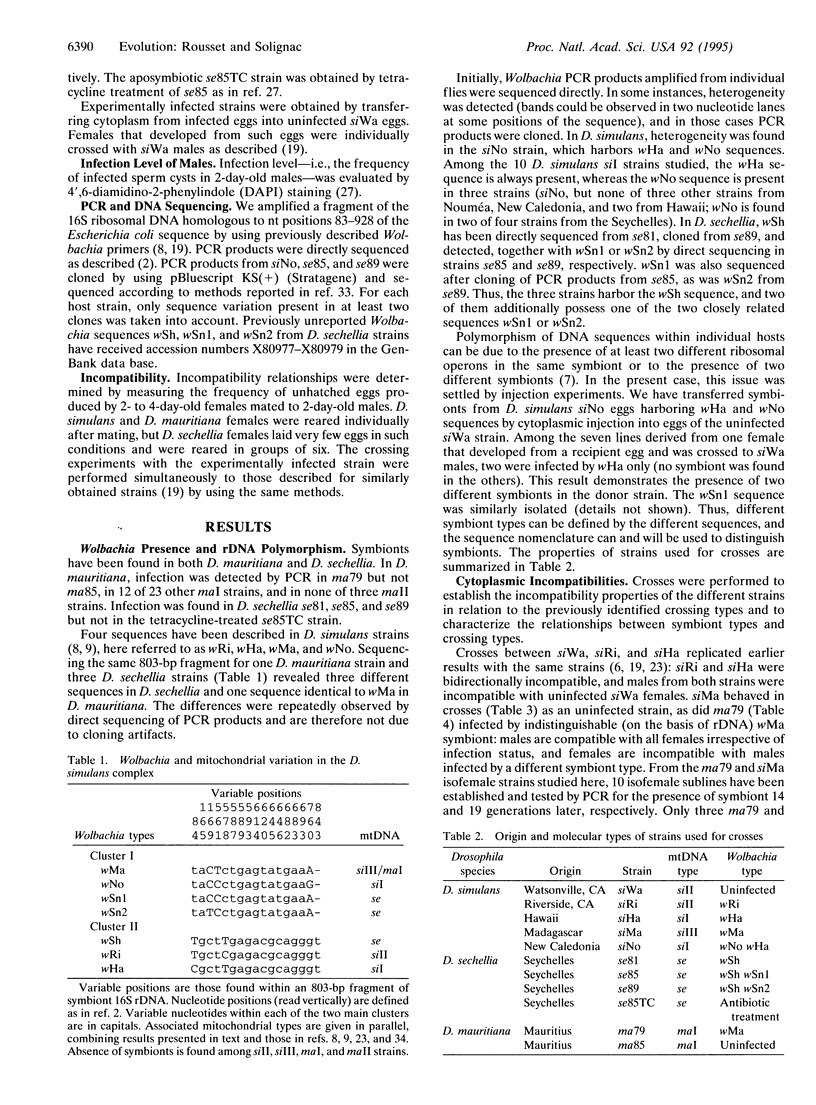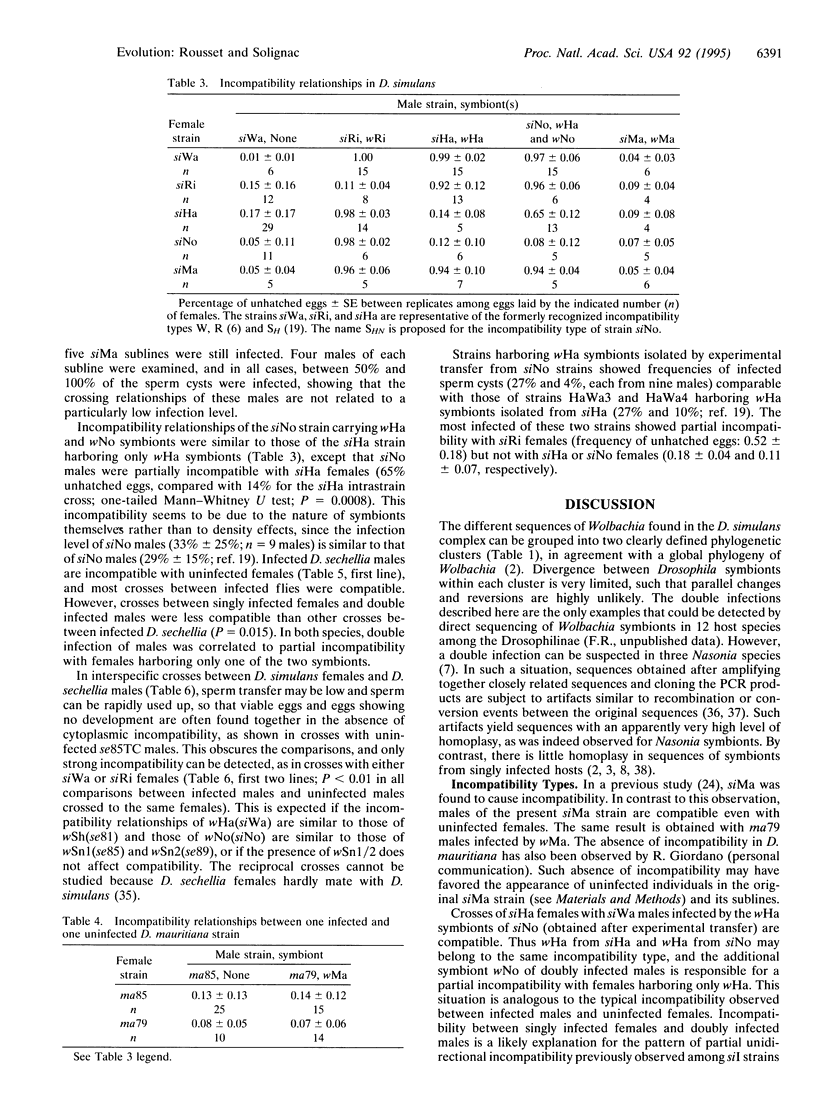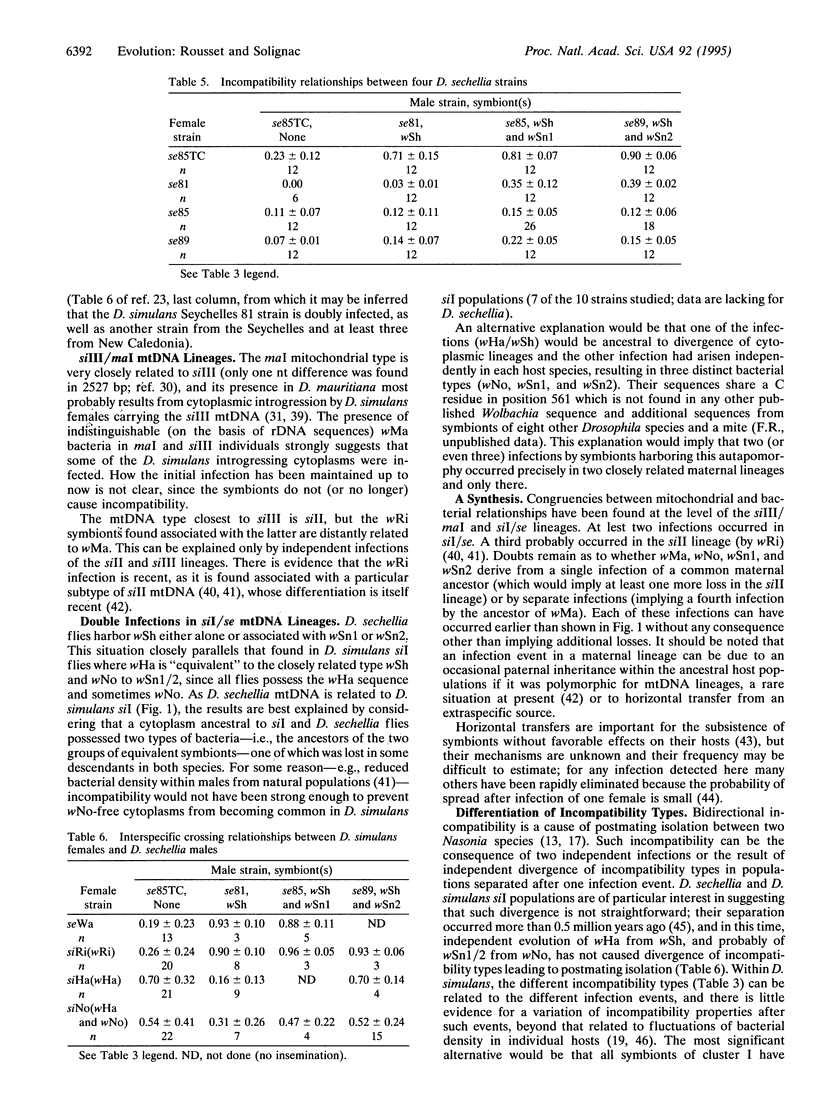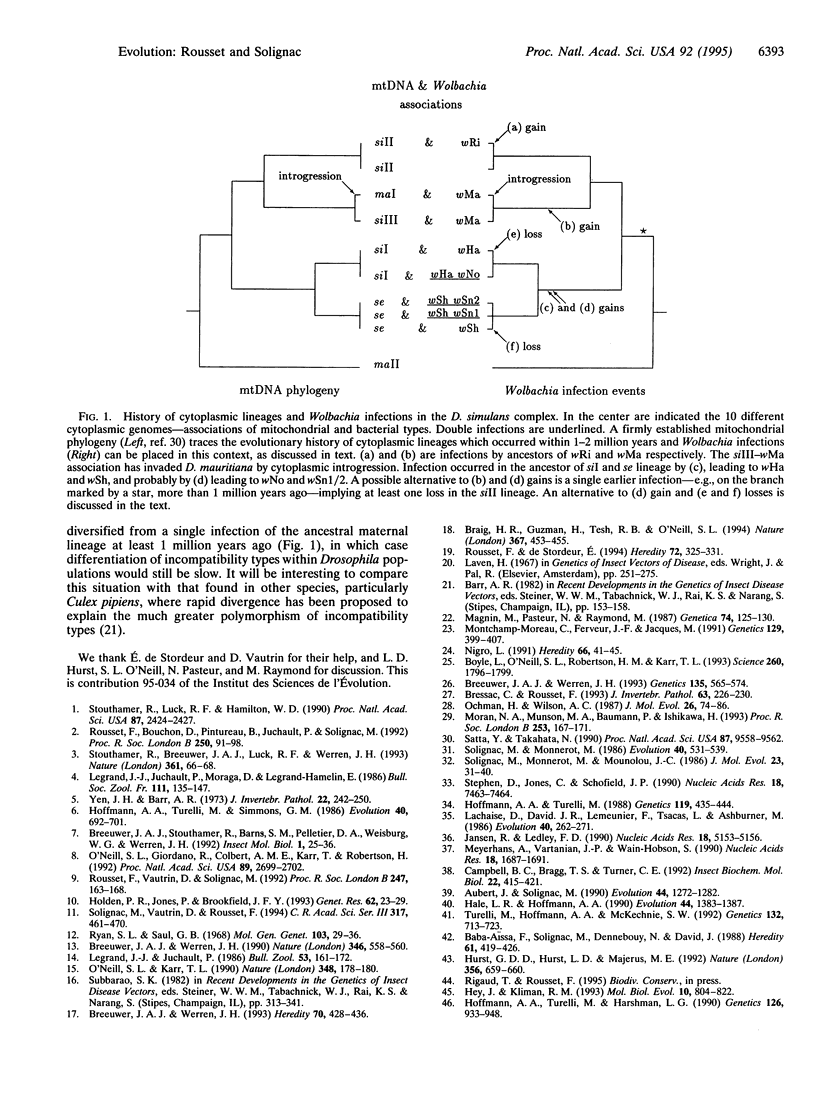Abstract
Maternally inherited bacteria of the genus Wolbachia are responsible for the early death of embryos in crosses between uninfected females and infected males in several insect species. This phenomenon, known as cytoplasmic incompatibility, also occurs between strains infected by different symbionts in some species, including Drosophila simulans. Wolbachia was found in two species closely related to D. simulans, Drosophila mauritiana, and Drosophila sechellia, and shown to cause incompatibility in the latter species but not in D. mauritiana. Comparison of bacterial and mtDNA history clarifies the origins of bacterial and incompatibility polymorphisms in D. simulans. Infection in D. mauritiana is probably the result of introgression of an infected D. simulans cytoplasm. Some D. simulans and D. sechellia cytoplasmic lineages harbor two bacteria as a consequence of a double infection which probably occurred in a common ancestor. The descendant symbionts in each species are associated with similar incompatibility relationships, which suggests that little variation of incompatibility types has occurred within maternal lineages beyond that related to the density of symbionts in their hosts.
Full text
PDF




Selected References
These references are in PubMed. This may not be the complete list of references from this article.
- Baba-Aïssa F., Solignac M., Dennebouy N., David J. R. Mitochondrial DNA variability in Drosophila simulans: quasi absence of polymorphism within each of the three cytoplasmic races. Heredity (Edinb) 1988 Dec;61(Pt 3):419–426. doi: 10.1038/hdy.1988.133. [DOI] [PubMed] [Google Scholar]
- Boyle L., O'Neill S. L., Robertson H. M., Karr T. L. Interspecific and intraspecific horizontal transfer of Wolbachia in Drosophila. Science. 1993 Jun 18;260(5115):1796–1799. doi: 10.1126/science.8511587. [DOI] [PubMed] [Google Scholar]
- Braig H. R., Guzman H., Tesh R. B., O'Neill S. L. Replacement of the natural Wolbachia symbiont of Drosophila simulans with a mosquito counterpart. Nature. 1994 Feb 3;367(6462):453–455. doi: 10.1038/367453a0. [DOI] [PubMed] [Google Scholar]
- Breeuwer J. A., Stouthamer R., Barns S. M., Pelletier D. A., Weisburg W. G., Werren J. H. Phylogeny of cytoplasmic incompatibility micro-organisms in the parasitoid wasp genus Nasonia (Hymenoptera: Pteromalidae) based on 16S ribosomal DNA sequences. Insect Mol Biol. 1992;1(1):25–36. doi: 10.1111/j.1365-2583.1993.tb00074.x. [DOI] [PubMed] [Google Scholar]
- Breeuwer J. A., Werren J. H. Microorganisms associated with chromosome destruction and reproductive isolation between two insect species. Nature. 1990 Aug 9;346(6284):558–560. doi: 10.1038/346558a0. [DOI] [PubMed] [Google Scholar]
- Hey J., Kliman R. M. Population genetics and phylogenetics of DNA sequence variation at multiple loci within the Drosophila melanogaster species complex. Mol Biol Evol. 1993 Jul;10(4):804–822. doi: 10.1093/oxfordjournals.molbev.a040044. [DOI] [PubMed] [Google Scholar]
- Hoffmann A. A., Turelli M., Harshman L. G. Factors affecting the distribution of cytoplasmic incompatibility in Drosophila simulans. Genetics. 1990 Dec;126(4):933–948. doi: 10.1093/genetics/126.4.933. [DOI] [PMC free article] [PubMed] [Google Scholar]
- Hoffmann A. A., Turelli M. Unidirectional incompatibility in Drosophila simulans: inheritance, geographic variation and fitness effects. Genetics. 1988 Jun;119(2):435–444. doi: 10.1093/genetics/119.2.435. [DOI] [PMC free article] [PubMed] [Google Scholar]
- Holden P. R., Jones P., Brookfield J. F. Evidence for a Wolbachia symbiont in Drosophila melanogaster. Genet Res. 1993 Aug;62(1):23–29. doi: 10.1017/s0016672300031529. [DOI] [PubMed] [Google Scholar]
- Hurst G. D., Hurst L. D., Majerus M. E. Evolutionary genetics. Selfish genes move sideways. Nature. 1992 Apr 23;356(6371):659–660. doi: 10.1038/356659a0. [DOI] [PubMed] [Google Scholar]
- Meyerhans A., Vartanian J. P., Wain-Hobson S. DNA recombination during PCR. Nucleic Acids Res. 1990 Apr 11;18(7):1687–1691. doi: 10.1093/nar/18.7.1687. [DOI] [PMC free article] [PubMed] [Google Scholar]
- Montchamp-Moreau C., Ferveur J. F., Jacques M. Geographic distribution and inheritance of three cytoplasmic incompatibility types in Drosophila simulans. Genetics. 1991 Oct;129(2):399–407. doi: 10.1093/genetics/129.2.399. [DOI] [PMC free article] [PubMed] [Google Scholar]
- Munson M. A., Baumann L., Baumann P. Buchnera aphidicola (a prokaryotic endosymbiont of aphids) contains a putative 16S rRNA operon unlinked to the 23S rRNA-encoding gene: sequence determination, and promoter and terminator analysis. Gene. 1993 Dec 31;137(2):171–178. doi: 10.1016/0378-1119(93)90003-l. [DOI] [PubMed] [Google Scholar]
- Nigro L. The effect of heteroplasmy on cytoplasmic incompatibility in transplasmic lines of Drosophila simulans showing a complete replacement of the mitochondrial DNA. Heredity (Edinb) 1991 Feb;66(Pt 1):41–45. doi: 10.1038/hdy.1991.5. [DOI] [PubMed] [Google Scholar]
- O'Neill S. L., Giordano R., Colbert A. M., Karr T. L., Robertson H. M. 16S rRNA phylogenetic analysis of the bacterial endosymbionts associated with cytoplasmic incompatibility in insects. Proc Natl Acad Sci U S A. 1992 Apr 1;89(7):2699–2702. doi: 10.1073/pnas.89.7.2699. [DOI] [PMC free article] [PubMed] [Google Scholar]
- O'Neill S. L., Karr T. L. Bidirectional incompatibility between conspecific populations of Drosophila simulans. Nature. 1990 Nov 8;348(6297):178–180. doi: 10.1038/348178a0. [DOI] [PubMed] [Google Scholar]
- Ochman H., Wilson A. C. Evolution in bacteria: evidence for a universal substitution rate in cellular genomes. J Mol Evol. 1987;26(1-2):74–86. doi: 10.1007/BF02111283. [DOI] [PubMed] [Google Scholar]
- Rousset F., Bouchon D., Pintureau B., Juchault P., Solignac M. Wolbachia endosymbionts responsible for various alterations of sexuality in arthropods. Proc Biol Sci. 1992 Nov 23;250(1328):91–98. doi: 10.1098/rspb.1992.0135. [DOI] [PubMed] [Google Scholar]
- Rousset F., Vautrin D., Solignac M. Molecular identification of Wolbachia, the agent of cytoplasmic incompatibility in Drosophila simulans, and variability in relation with host mitochondrial types. Proc Biol Sci. 1992 Mar 23;247(1320):163–168. doi: 10.1098/rspb.1992.0023. [DOI] [PubMed] [Google Scholar]
- Rousset F., de Stordeur E. Properties of Drosophila simulans strains experimentally infected by different clones of the bacterium Wolbachia. Heredity (Edinb) 1994 Apr;72(Pt 4):325–331. doi: 10.1038/hdy.1994.48. [DOI] [PubMed] [Google Scholar]
- Ryan S. L., Saul G. B., 2nd Post-fertilization effect of incompatibility factors in Mormoniella. Mol Gen Genet. 1968;103(1):29–36. doi: 10.1007/BF00271154. [DOI] [PubMed] [Google Scholar]
- Satta Y., Takahata N. Evolution of Drosophila mitochondrial DNA and the history of the melanogaster subgroup. Proc Natl Acad Sci U S A. 1990 Dec;87(24):9558–9562. doi: 10.1073/pnas.87.24.9558. [DOI] [PMC free article] [PubMed] [Google Scholar]
- Solignac M., Monnerot M., Mounolou J. C. Mitochondrial DNA evolution in the melanogaster species subgroup of Drosophila. J Mol Evol. 1986;23(1):31–40. doi: 10.1007/BF02100996. [DOI] [PubMed] [Google Scholar]
- Stephen D., Jones C., Schofield J. P. A rapid method for isolating high quality plasmid DNA suitable for DNA sequencing. Nucleic Acids Res. 1990 Dec 25;18(24):7463–7464. doi: 10.1093/nar/18.24.7463. [DOI] [PMC free article] [PubMed] [Google Scholar]
- Stouthamer R., Breeuwert J. A., Luck R. F., Werren J. H. Molecular identification of microorganisms associated with parthenogenesis. Nature. 1993 Jan 7;361(6407):66–68. doi: 10.1038/361066a0. [DOI] [PubMed] [Google Scholar]
- Stouthamer R., Luck R. F., Hamilton W. D. Antibiotics cause parthenogenetic Trichogramma (Hymenoptera/Trichogrammatidae) to revert to sex. Proc Natl Acad Sci U S A. 1990 Apr;87(7):2424–2427. doi: 10.1073/pnas.87.7.2424. [DOI] [PMC free article] [PubMed] [Google Scholar]
- Turelli M., Hoffmann A. A., McKechnie S. W. Dynamics of cytoplasmic incompatibility and mtDNA variation in natural Drosophila simulans populations. Genetics. 1992 Nov;132(3):713–723. doi: 10.1093/genetics/132.3.713. [DOI] [PMC free article] [PubMed] [Google Scholar]
- Yen J. H., Barr A. R. The etiological agent of cytoplasmic incompatibility in Culex pipiens. J Invertebr Pathol. 1973 Sep;22(2):242–250. doi: 10.1016/0022-2011(73)90141-9. [DOI] [PubMed] [Google Scholar]


